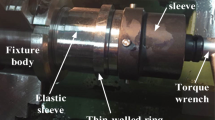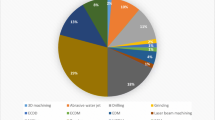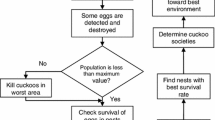Abstract
This study proposes glowworm swarm optimization (GSO) algorithm to estimate an improved value of machining performance measurement. GSO is a recent nature-inspired optimization algorithm that simulates the behavior of the lighting worms. To the best our knowledge, GSO algorithm has not yet been used for optimization practice particularly in machining process. Three cutting parameters of end milling that influence the machining performance measurement, minimum surface roughness, are cutting speed, feed rate and depth of cut. Taguchi method is performed for experimental design. The analysis of variance is applied to investigate effects of cutting speed, feed rate and depth of cut on surface roughness. GSO has improved machining process by estimating a much lower value of minimum surface roughness compared to the results of experimental and particle swarm optimization.



Similar content being viewed by others
References
Agrawal, R. K., Pratihar, D. K., & Roy Choudhury, A. (2006). Optimization of CNC isoscallop free form surface machining using a genetic algorithm. International Journal of Machine Tools and Manufacture, 46(7), 811–819.
Antony, J., Anand, R. B., Kumar, M., & Tiwari, M. K. (2006). Multiple response optimization using Taguchi methodology and neuro-fuzzy based model. Journal of Manufacturing Technology Management, 17(7), 908–925.
Bharathi Raja, S., & Baskar, N. (2012). Application of particle swarm optimization technique for achieving desired milled surface roughness in minimum machining time. Expert Systems with Applications, 39(5), 5982–5989.
Ghani, J. A., Choudhury, I. A., & Hassan, H. H. (2004). Application of Taguchi method in the optimization of end milling parameters. Journal of Materials Processing Technology, 145(1), 84–92.
Gopalsamy, B. M., Mondal, B., & Ghosh, S. (2009). Taguchi method and ANOVA: An approach for process parameters optimization of hard machining while machining hardened steel. Journal of Scientific & Industrial Research, 68(8), 686–695.
Hamdan, A., Sarhan, A. A., & Hamdi, M. (2012). An optimization method of the cutting parameters in high-speed machining of stainless steel using coated carbide tool for best surface finish. The International Journal of Advanced Manufacturing Technology, 58(1–4), 81–91.
Hasçalık, A., & Çaydaş, U. (2008). Optimization of turning parameters for surface roughness and tool life based on the Taguchi method. The International Journal of Advanced Manufacturing Technology, 38(9–10), 896–903.
He, D. & Zhu, H. (2010). Glowworm swarm optimization algorithm based on multi-population. In Sixth international conference on natural computation, pp. 2624–2627.
Johari, N. F., Zain, A. M., Mustaffa, N. H., & Udin, A. (2013). Firefly algorithm for optimization problem. Applied Mechanics and Materials, 421, 512–517.
Kamaruzaman, A. F., Zain, A. M., Yusuf, S. M., & Udin, A. (2013). Levy flight algorithm for optimization problems-a literature review. Applied Mechanics and Materials, 421, 496–501.
Kondapalli, S. P., Chalamalasetti, S. R., & Damera, N. R. (2013). Application of Taguchi based design of experiments to fusion arc weld processes: A review. Internation Journal of Technology and Management, ISSN 1927–9000, 2(1), 1–8.
Krimpenis, A., & Vosniakos, G. C. (2009). Rough milling optimization for parts with sculptured surfaces using genetic algorithms in a Stackelberg game. Journal of Intelligent Manufacturing, 20(4), 447–461.
Krishnanand, K. N. & Ghose, D. (2005). Detection of multiple source locations using a glowworm metaphor with applications to collective robotics. In Swarm Intelligence Symposium, 2005. SIS 2005. Proceedings 2005 IEEE (pp. 84–91). IEEE.
Krishnanand, K. N., & Ghose, D. (2006). Theoretical foundations for multiple rendezvous of glowworm-inspired mobile agents with variable local-decision domains. In American control conference, 2006 (p. 6). IEEE.
Krishnanand, K. N., & Ghose, D. (2009). A glowworm swarm optimization based multi-robot system for signal source localization. In Design and control of intelligent robotic systems (pp. 49–68). Springer, Berlin.
Li, L., Liu, F., Chen, B., & Li, C. B. (2013). Multi-objective optimization of cutting parameters in sculptured parts machining based on neural network. Journal of Intelligent Manufacturing. doi:10.1007/s10845-013-0809-z.
Luo, Q. F., & Zhang, J. L. (2011). Hybrid artificial glowworm swarm optimization for solving constrained engineering problem. Advanced Materials Research, 204, 823–827.
Magdum, V. B., & Naik, V. R. (2013). Evaluation and optimization of machining parameter for turning of EN 8 steel. International Journal of Engineering Trends and Technology (IJTT), 4(5), 1564–1568.
Maji, K., & Pratihar, D. K. (2011). Modeling of electrical discharge machining process using conventional regression analysis and genetic algorithms. Journal of Materials Engineering and Performance, 20(7), 1121–1127.
Markopoulos, A. P., Manolakos, D. E., & Vaxevanidis, N. M. (2008). Artificial neural network models for the prediction of surface roughness in electrical discharge machining. Journal of Intelligent Manufacturing, 19(3), 283–292.
Mohamad, A., Zain, A. M., Bazin, N. E. N., & Udin, A. (2013). Cuckoo search algorithm for optimization problems—a literature review. Applied Mechanics and Materials, 421, 502–506.
Motorcu, A. R. (2010). The optimization of machining parameters using the Taguchi method for surface roughness of AISI 8660 hardened alloy steel. Journal of Mechanical Engineering, 56(2010), 391–401.
Nandi, A. K., & Pratihar, D. K. (2004). An expert system based on FBFN using a GA to predict surface finish in ultra-precision turning. Journal of Materials Processing Technology, 155, 1150–1156.
Oramus, P. (2010). Improvements to glowworm swarm optimization algorithm. Journal of Computer Science, 11, 7–20.
Periyanan, P. R., Natarajan, U., & Yang, S. H. (2011). A study on the machining parameters optimization of micro-end milling process. International Journal of Engineering, Science and Technology, 3(6), 237–246.
Raju, K. V. M. K., Janardhana, G. R., Kumar, P. N., & Rao, V. D. P. (2011). Optimization of machining conditions for surface roughness in CNC end milling. International Journal of Precision Engineering and Manufacturing, 12(3), 383–391.
Sahoo, A. K., Tiwari, M. K., & Mileham, A. R. (2008). Six sigma based approach to optimize radial forging operation variables. Journal of Materials Processing Technology, 202(1), 125–136.
Senthilkumaar, J. S., Selvarani, P., & Arunachalam, R. M. (2010). Selection of cutting parameters based on the analysis of surface roughness and flank wear in finish turning and facing of inconel 718 using taguchi technique. Emirates Journal for Engineering Research, 15(2), 7–14.
Sibalija, T. V., & Majstorovic, V. D. (2012). An integrated approach to optimise parameter design of multi-response processes based on Taguchi method and artificial intelligence. Journal of Intelligent Manufacturing, 23(5), 1511–1528.
Tiwari, M. K., Raghavendra, N., Agrawal, S., & Goyal, S. K. (2010). A hybrid Taguchi-immune approach to optimize an integrated supply chain design problem with multiple shipping. European Journal of Operational Research, 203(1), 95–106.
Wang, G., Wang, Y., Zhao, J., & Chen, G. (2012). Process optimization of the serial-parallel hybrid polishing machine tool bsed on artificial neural network and genetic algorithm. Journal of Intelligent Manufacturing, 2(3), 365–374.
Yusup, N., Zain, A. M., & Hashim, S. Z. M. (2012). Overview of PSO for optimizing process parameters of machining. Procedia Engineering, 29, 914–923.
Zain, A. M., Haron, H., & Sharif, S. (2010a). Application of GA to optimize cutting conditions for minimizing surface roughness in end milling machining process. Expert System with Applications, 37, 4650–4659.
Zain, A. M., Haron, H., & Sharif, S. (2010b). Prediction of surface roughness in the end milling machining using artificial neural network. Expert System with Applications, 37, 1755–1768.
Zain, A. M., Haron, H., & Sharif, S. (2010c). Simulated annealing to estimate the optimal cutting conditions for minimizing surface roughness in end milling Ti-6Al-4V. Machining Science and Technology, 14, 43–62.
Zain, A. M., Haron, H., & Sharif, S. (2011a). Estimation of the minimum machining performance in the abrasive waterjet machining using integrated ANN-SA. Expert Systems with Applications, 38(7), 8316–8326.
Zain, A. M., Haron, H., & Sharif, S. (2011b). Integration of simulated annealing and genetic algorithm to estimate optimal solutions for minimising surface roughness in end milling Ti-6AL-4V. International Journal of Computer Integrated Manufacturing, 24, 574–592.
Zain, A. M., Haron, H., & Sharif, S. (2011c). Genetic algorithm and simulated annealing to estimate optimal process parameters of the abrasive waterjet machining. Engineering with Computers, 27, 251–259.
Zain, A. M., Haron, H., & Sharif, S. (2012a). Integrated ANN-GA for estimating the minimum value for machining performance. International Journal of Production Research, 50(1), 191–213.
Zain, A. M., Haron, H., Qasem, S. N., & Sharif, S. (2012b). Regression and ANN models for estimating minimum value of machining performance. Applied Mathematical Modelling, 36(4), 1477–1492.
Zainal, N., Zain, A. M., Radzi, N. H. M., & Udin, A. (2013). Glowworm swarm optimization (GSO) algorithm for optimization problems: A state-of-the-art review. Applied Mechanics and Materials, 421, 507–511.
Acknowledgments
Special appreciation to reviewer(s) for useful advices and comments. The authors greatly acknowledge Soft Computing Research Group (SCRG UTM), Research Management Centre (RMC UTM) and Ministry of Higher Education Malaysia (MOHE) for financial support through the Exploratory Research Grant Scheme (ERGS) No. R.J130000.7828.4L087
Author information
Authors and Affiliations
Corresponding author
Rights and permissions
About this article
Cite this article
Zainal, N., Zain, A.M., Radzi, N.H.M. et al. Glowworm swarm optimization (GSO) for optimization of machining parameters. J Intell Manuf 27, 797–804 (2016). https://doi.org/10.1007/s10845-014-0914-7
Received:
Accepted:
Published:
Issue Date:
DOI: https://doi.org/10.1007/s10845-014-0914-7




